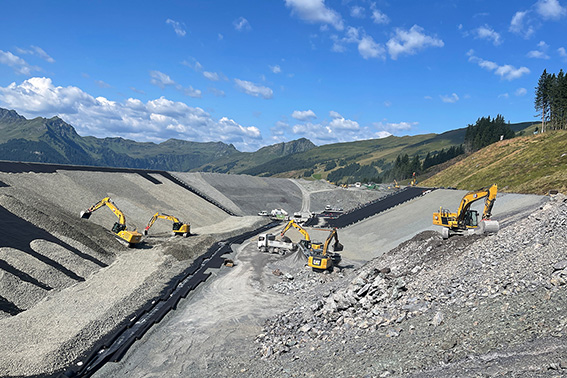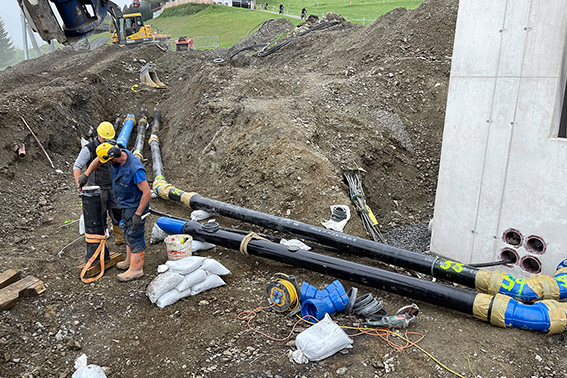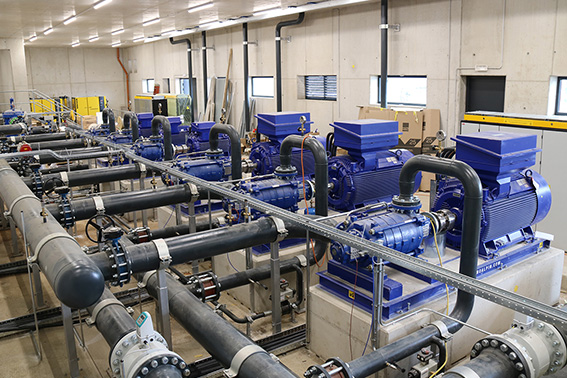
Saalbach-Hinterglemm: "Lifelines" Made in Austria at Reiterkogel
BBSH Bergbahnen Saalbach-Hinterglemm launched a two-year construction project in summer 2020 to increase the effectiveness of technical snowmaking on the Reiterkogel. It includes the new Rosswald storage pond and a new pumping station. For the field pipelines, the mountain railroad once again relied on the ductile iron pipes of Tiroler Rohre GmbH, after all they form the "lifeline" for the water supply of the technical snowmaking system. This year in August, the ISR informed itself about the construction progress during an on-site inspection. The Reiterkogel cable car in Hinterglemm took us up to the top of the Reiterkogel. After getting off at the top station and a short walk to the new Rosswald reservoir at 1,550 m above sea level, the construction site was bustling with activity. The new Rosswald reservoir has a usable capacity of 230,000 m³ and is named after the area in which it is located. It is located directly on the multifunctional trail between Rosswaldhütte and Wieseralm.
Rosswald storage pond and pumping station
BBSH Bergbahnen Saalbach-Hinterglemm had been looking for a suitable location for a storage pond on the Reiterkogel for five years to supply the ski area between Rosswald and Reiterkogel. Christopher Kendler, Deputy Operations Manager Reiterkogel, who is responsible for site supervision together with Reiterkogel Operations Manager Thomas Wallinger, explains: "Here we have found a site that is at all compensable. The construction area is about 7 hectares, and the compensation area is 18 hectares. We have had to build foundations on rock everywhere. Since we already had an approved quarry on this site, we were able to excavate, crush, screen, place and compact all the gravel and dam fill on site, for example, and didn't have to haul the required material uphill from the valley." Because of the dam's 38-meter height, a permit from the Austrian Reservoir Commission was required. Operations Manager Deputy Christopher Kendler informs, "At the widest point, the dam body has a diameter of 100 m, with the peculiarity that the air-side backfill (= dam body) has more volume than the usable volume. This is due to the fact that the terrain was previously correspondingly steep and we had to start relatively far down for the necessary construction work." The new Rosswald storage pond replaces the previous, nearby Reiterkogel I storage pond with a usable capacity of 40,000 m³. A filling pipeline was laid from there to fill the new reservoir with water. In addition, there is a water intake from a stream, and rainwater is also collected. In order to meet the requirement of the Austrian Reservoir Commission to be able to guarantee the emergency emptying of the Rosswald reservoir in 72 hours (= approx. 1,000 l/sec) at maximum water level, an additional effort had to be made due to the local conditions and the steep terrain. For this purpose, 1.6 km of DN500 ductile iron pipes from Tiroler Rohre GmbH (TRM) were laid. BBSH Bergbahnen Saalbach-Hinterglemm has been relying on the pipe systems "Made in Austria" from Hall since 1992. Managing Director Alexander Gensbichler emphasizes, "The high-quality TRM pipe systems have proven themselves in our ski area, and we are very satisfied with them. This also applies to the support." The new Rosswald storage pond was designed to be close to nature and is also intended for summer use. The first filling will take place this year in October. A new pumping station of the same name has also been built at the foot of the new Rosswald reservoir (general contractor: TechnoAlpin). It supplements the existing pumping station at the Reiterkogel I reservoir, which was built in 2000. The Rosswald pumping station has a total pumping capacity of 520 l/s and a total installed capacity of 3.2 MW. In addition, it is equipped with a cooling tower system. The lake pre-cooling system adjusts the output of the individual snow generators, thus increasing energy efficiency.
The field line construction
So far, about 8 km of field pipelines have been laid. TRM sales manager Dr. Igor Roblek explains: "Our ductile iron pipes in diameters DN80 to DN600, which can be used up to a pressure rating of 100 bar, were used for this. Around 5 km of these pipes were laid in the diameter DN300 with a nominal pressure rating of PN 63. Our ductile iron pipes have excellent corrosion protection and a very long service life. Our patented VRS®-T connection system with the waling set is easy, fast and safe to install." This statement is also confirmed by deputy plant manager Christopher Kendler: "Laying the push-fit joint system is quick to learn and easy to handle. The fact that the joints are designed like a ball joint and can be angled by up to 5 degrees, depending on the dimension, means that fewer fittings are needed. In addition, the VRS®-T pipe system is very safe. We have never had any damage so far. I am really very satisfied with the cooperation with TRM. The company is always reliable and uncomplicated. The quality of the ductile iron pipes is excellent, and the choice of dimensions, pressure ratings and fittings is huge. The supply of needed parts also works very quickly. If we need something urgently, we receive it the very next day in the morning." The central warehouse at TRM's headquarters in Hall in Tirol has a stock of about 10,000 t of pipes and about 1,000 t (= about 40,000 pieces) of fittings. In the upcoming winter season 2021/22, the Rosswald storage pond and the Rosswald pumping station will already be available for technical snowmaking in the Saalbach Hinterglemm Leogang Fieberbrunn ski circus. Whereby the full capacity for technical snowmaking can only be utilized for the winter season 2022/23. Nevertheless, the effectiveness of technical snowmaking in the ski area between Rosswald and Reiterkogel is already many times greater than before. The current inventory of 100 snowmakers (TechnoAlpin, 70 propeller machines, 30 snow lances) is also to be further expanded. In total, BBSH Bergbahnen Saalbach-Hinterglemm currently makes snow on 59 hectares of slopes on the Reiterkogel. With the current expansion, technical basic snowmaking will be possible in about 8 days.
Internationale Seilbahnrundschau (ISR), Claudia Mantona


